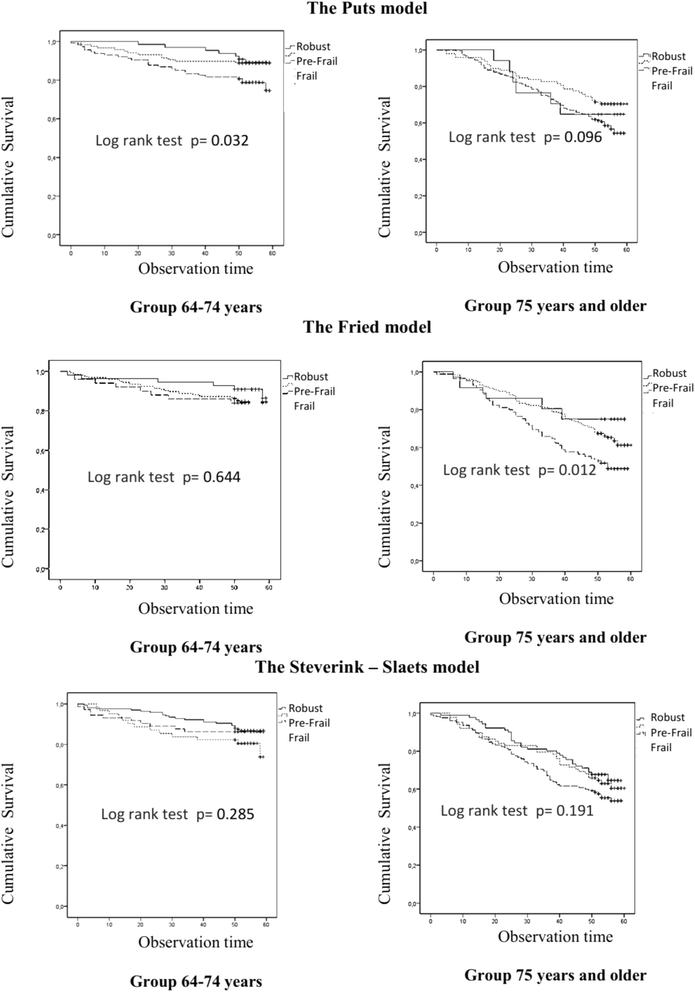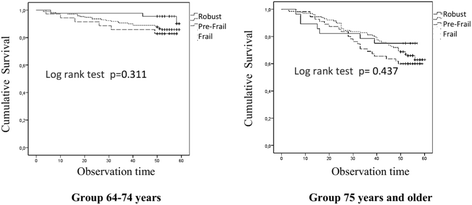Do commonly used frailty models predict mortality, loss of autonomy and mental decline in older adults in northwestern Russia? A prospective cohort study
- PMID: 27160275
- PMCID: PMC4862060
- DOI: 10.1186/s12877-016-0276-4
Do commonly used frailty models predict mortality, loss of autonomy and mental decline in older adults in northwestern Russia? A prospective cohort study
Abstract
Background: Frailty prevalence differs across countries depending on the models used to assess it that are based on various conceptual and operational definitions. This study aims to assess the clinical validity of three frailty models among community-dwelling older adults in north-western Russia where there is a higher incidence of cardiovascular disease and lower life expectancy than in European countries.
Methods: The Crystal study is a population-based prospective cohort study in Kolpino, St. Petersburg, Russia. A random sample of the population living in the district was stratified into two age groups: 65-75 (n = 305) and 75+ (n = 306) and had a baseline comprehensive health assessment followed by a second one after 33.4 +/-3 months. The total observation time was 47 +/-14.6 months. Frailty was assessed according to the models of Fried, Puts and Steverink-Slaets. Its association with mortality at 5 years follow-up as well as dependency, mental and physical decline at around 2.5 years follow up was explored by multivariable and time-to-event analyses.
Results: Mortality was predicted independently from age, sex and comorbidities only by the frail status of the Fried model in those over 75 years old [HR (95 % CI) = 2.50 (1.20-5.20)]. Mental decline was independently predicted only by pre-frail [OR (95 % CI) = 0.24 (0.10-0.55)] and frail [OR (95 % CI) = 0.196 (0.06-0.67)] status of Fried model in those 65-75 years old. The prediction of dependency and physical decline by pre-frail and frail status of any the three frailty models was not statistically significant in this cohort of older adults.
Conclusions: None of the three frailty models was valid at predicting 5 years mortality and disability, mental and physical decline at 2.5 years in a cohort of older adults in north-west Russia. Frailty by the Fried model had only limited value for mortality in those 75 years old and mental decline in those 65-75 years old. Further research is needed to identify valid frailty markers for older adults in this population.
Keywords: Dependency; Disability; Frailty; Mortality; Russia.
Figures



References
-
- The official website of State Statistics of Russia. [http://www.gks.ru/wps/wcm/connect/rosstat_main/rosstat/en/main/]. Accessed 19 Mar 2015.
-
- Walston J, Hadley EC, Ferrucci L, Guralnik JM, Newman AB, Studenski SA, Ershler WB, Harris T, Fried L. Research agenda for frailty in older adults: toward a better understanding of physiology and etiology: summary from the American Geriatrics Society/National Institute on Aging Research Conference on Frailty in Older Adults. J Am Geriatr Soc. 2006;54(6):991–1001. doi: 10.1111/j.1532-5415.2006.00745.x. - DOI - PubMed
-
- Rodríguez-Mañas L, Féart C, Mann G, Viña J, Chatterji S, Chodzko-Zajko W, Harmand MGC, Bergman H, Carcaillon L, Nicholson C, Scuteri A, Sinclair A, Pelaez M, Van der Cammen T, Beland F, Bickenbach J, Delamarche P, Ferrucci L, Fried LP, Gutiérrez-Robledo LM, Rockwood K, Artalejo FR, Serviddio G, Vega E. Searching for an operational definition of frailty: a Delphi method based consensus statement. the frailty operative definition - consensus conference project. J Gerontol A Biol Sci Med Sci. 2013;68(1):62–7. doi: 10.1093/gerona/gls119. - DOI - PMC - PubMed
Publication types
MeSH terms
LinkOut - more resources
Full Text Sources
Other Literature Sources
Medical

